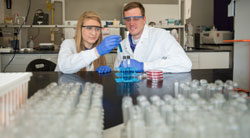Research
Dr. Trinetta's research interests include the minimization of foodborne illness risk and the investigation persistence and survival of pathogens through the entire food supply chain.
Current projects and Past Projects are shown below.
|
|
|
|
Current Projects
Antimicrobial efficacy of TiO2 against Listeria, Salmonella, and E. coli in microgreen systems
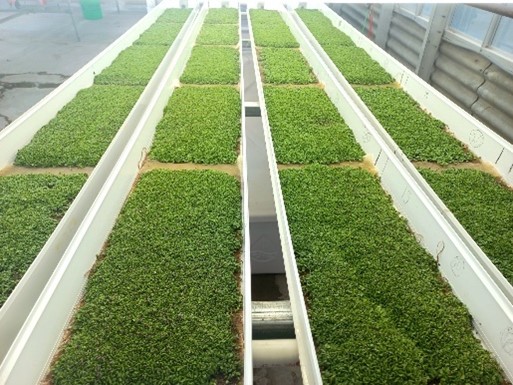 Microgreens are “superfoods” that have become increasingly popular due to their high nutritional value and versatility. These young vegetables have distinctive flavors and textures that make them suitable for use as garnishes in a variety of dishes. However, published reports have highlighted several food quality and safety risks associated with the production of microgreens in soil-substitute growing systems.
Microgreens are “superfoods” that have become increasingly popular due to their high nutritional value and versatility. These young vegetables have distinctive flavors and textures that make them suitable for use as garnishes in a variety of dishes. However, published reports have highlighted several food quality and safety risks associated with the production of microgreens in soil-substitute growing systems.
Chiara’s research project aims to reduce microbial load in the water reservoirs of microgreen systems. This is achieved by testing the antimicrobial efficacy of TiO2 powder under UV light against S. enteritidis, E. coli, and L. monocytogenes in vitro and on experimentally inoculated microgreen seeds and media.
Novel Sanitation Strategies to Control Listeria Biofilms in the Organic Produce Industry
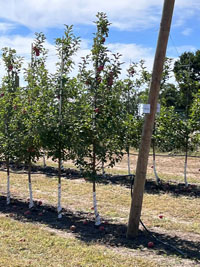 L. monocytogenes is a ubiquitous foodborne pathogen that poses a food safety challenge in the organic produce industry due to its biofilm formation ability on food contact surfaces. Biofilms can develop in hard-to-reach sites of the equipment and are difficult to eliminate since they are resistant to sanitizing agents. Considering their limited sanitation alternatives, it is even more challenging for organic produce growers to control Listeria. Thus, this project focuses on developing and validating novel sanitation strategies to control Listeria biofilms in the organic produce industry on food-contact surfaces and equipment.
L. monocytogenes is a ubiquitous foodborne pathogen that poses a food safety challenge in the organic produce industry due to its biofilm formation ability on food contact surfaces. Biofilms can develop in hard-to-reach sites of the equipment and are difficult to eliminate since they are resistant to sanitizing agents. Considering their limited sanitation alternatives, it is even more challenging for organic produce growers to control Listeria. Thus, this project focuses on developing and validating novel sanitation strategies to control Listeria biofilms in the organic produce industry on food-contact surfaces and equipment.
Controlling Biofilms on Food Contact Surfaces
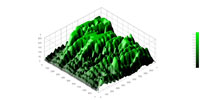 Listeria monocytogenes, E. coli, and Salmonella pose a food safety challenge for the produce industry due to their ability to form biofilms. Once biofilms are formed, they become difficult to remove. Equipment such as harvest bins and nylon picking bags may serve as reservoirs for these pathogens if not properly sanitized. Therefore, the focus of this project is to evaluate the ability of commercially available sanitizers to control Listeria monocytogenes, E. coli, and Salmonella biofilms. The objective of this research is to provide produce farmers with strategies to effectively sanitize harvest bins and nylon picking bags.
Listeria monocytogenes, E. coli, and Salmonella pose a food safety challenge for the produce industry due to their ability to form biofilms. Once biofilms are formed, they become difficult to remove. Equipment such as harvest bins and nylon picking bags may serve as reservoirs for these pathogens if not properly sanitized. Therefore, the focus of this project is to evaluate the ability of commercially available sanitizers to control Listeria monocytogenes, E. coli, and Salmonella biofilms. The objective of this research is to provide produce farmers with strategies to effectively sanitize harvest bins and nylon picking bags.
Novel Sorghum Applications
 Although sorghum is widely grown all over the world for food and feed, its nutritional benefits are limited due to the presence of anti-nutritional factors, known to interfere with protein and carbohydrate digestion and mineral bioavailability. Controlled fermentation can represent a suitable strategy to improve sorghum protein digestibility and increase functional properties. Fermented sorghum foods and drinks are widely used in other parts of the world, especially in Asia and Africa, but not yet in the United States.
Although sorghum is widely grown all over the world for food and feed, its nutritional benefits are limited due to the presence of anti-nutritional factors, known to interfere with protein and carbohydrate digestion and mineral bioavailability. Controlled fermentation can represent a suitable strategy to improve sorghum protein digestibility and increase functional properties. Fermented sorghum foods and drinks are widely used in other parts of the world, especially in Asia and Africa, but not yet in the United States.
This series of studies investigates the effects on fermentation dynamics and functional properties sorghum fermentation, in various forms of products from properties including microbial succession, taxonomic diversity, associated physical-chemical changes, metagenomic analysis and chemical analysis.
Biofilms on Food Contact Surfaces
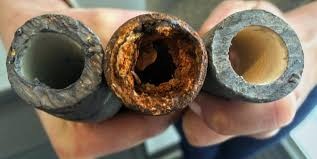 Listeria monocytogenes is one of the top food safety challenges for the produce industry due to its ability to form biofilms and association with other resident strains from food premises, in particular Pseudomonas spp. The prevalence and persistence of Listeria biofilms on food contact surfaces increases throughout time. After the biofilm formed, it becomes difficult to disrupt. Understanding bacteria adhesion and biofilm formation to different surfaces, might offer a better insight to antimicrobial treatment effectiveness. The objective of this research was to assess the formation and growth of mixed- species biofilms on different materials using a CDC Biofilm Reactor.
Listeria monocytogenes is one of the top food safety challenges for the produce industry due to its ability to form biofilms and association with other resident strains from food premises, in particular Pseudomonas spp. The prevalence and persistence of Listeria biofilms on food contact surfaces increases throughout time. After the biofilm formed, it becomes difficult to disrupt. Understanding bacteria adhesion and biofilm formation to different surfaces, might offer a better insight to antimicrobial treatment effectiveness. The objective of this research was to assess the formation and growth of mixed- species biofilms on different materials using a CDC Biofilm Reactor.
Some of the Past Projects
Sanitation Strategies for Food Contact Surfaces Common in Fresh Food Markets in Cambodia
Sanitation Practices for Improved Food Safety at Farmers Markets
Improving the Safety of Cambodia's Vegetable Value Chain
Feed Safety and Salmonella Ecology
Improving the safety and quality of leafy greens
Survival of Salmonella in Animal Fat Intended for Pet Food Use
Understanding Listeria monocytogenes Biofilm
Investigation of the prevalence and distribution of Salmonella in feed mills
Antifungal packaging films to control postharvest diseases in strawberries

